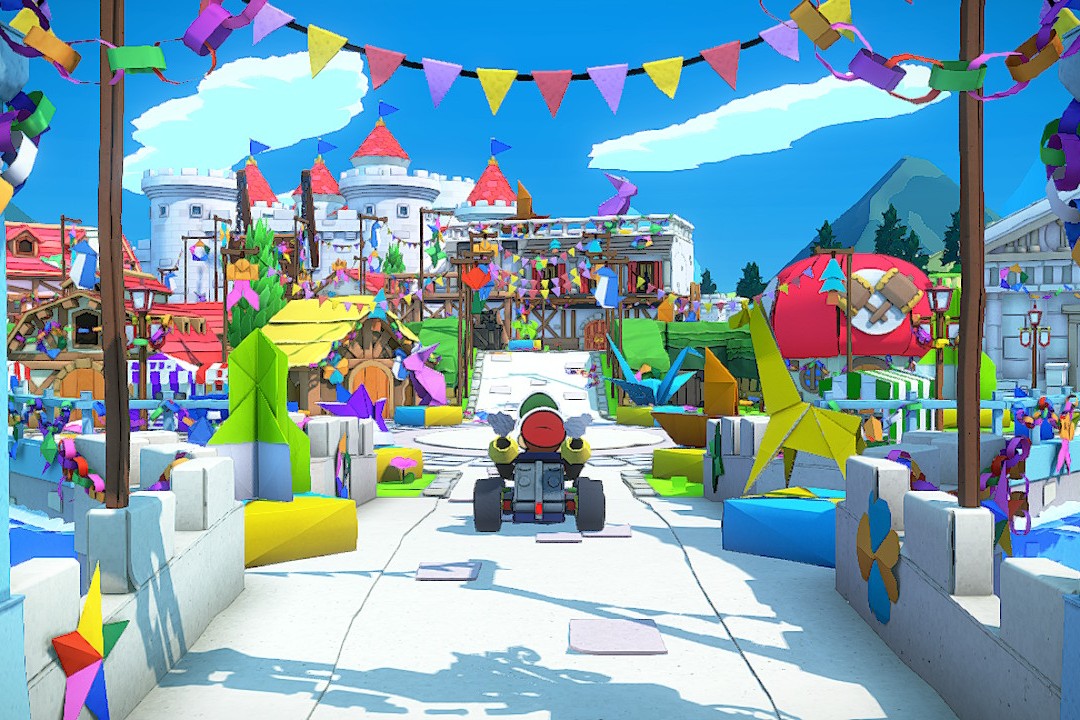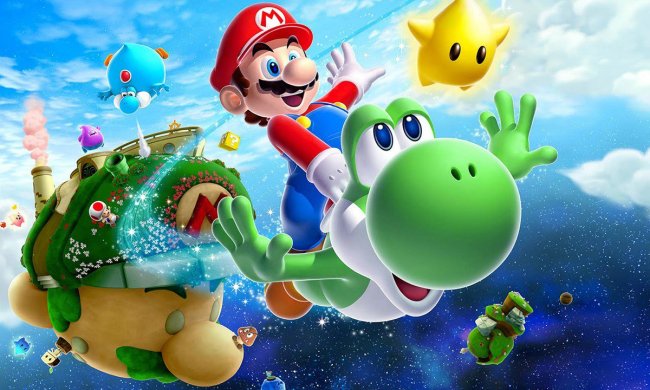“Paper Mario: The Origami King is a charming Mario adventure marred by a difficult and tedious battle system.”
- Heartwarming characters
- Beautiful soundtrack
- Excellent level variety
- Stunning visuals
- Annoying battle system
- Platforming can lack precision
About a third of the way through Paper Mario: The Origami King, a Bob-omb performs a touching act of self-sacrifice.
One of the game’s main characters, Olivia, is incapacitated, and it’s up to Mario and the Bob-omb to save her. A quest to find an item ensued, and when they returned to Olivia, I realized Bob-omb knew he was going to do this selfless act all along, even though I didn’t. It’s a beautiful scene, and it reminded me why I love video games in the first place.
Paper Mario: The Origami King shines the brightest in these moments. It’s a shame a frustrating battle system drags down this otherwise great game.

The paper rout
The game’s story is fairly simple Mario fare. Mario and Luigi are on their way to the Mushroom Kingdom for an origami festival, but when they get there, something is afoot. Princess Peach is folded and acting creepy, and she asks the brothers if they want to join her. When they refuse, they’re dropped into the castle’s dungeon. You soon learn an evil origami king named Ollie has transformed the princess into this lifeless form, and a cadre of Bowser’s enemies into folded soldiers. He wants to do the same to the whole Mushroom Kingdom.
Mario teams up with Bowser, who is hilariously folded into a square, and tries to escape imprisonment. He finds Olivia, Ollie’s sister, in the dungeon. Olivia doesn’t share her brother’s hatred, and so they begin a quest to save the kingdom and stop Ollie’s evil plan.
Ollie takes Peach’s castle and moves it to a faraway mountain, and he covers the kingdom in five colorful ribbons, trapping everything. It’s up to Mario and Olivia (and a bevy of supporting characters) to unspool the ribbons, stop Ollie, and return the kingdom to normal.
So far, so good, but the narrative becomes more convoluted from there. Mario and Olivia need to defeat four origami elementals (fire, ice, water, earth) so Olivia can learn their powers and become strong enough to take on super-powered office supplies (scissors, stapler, a hole punch, et cetera) guarding the ribbons. They also discover Ollie’s origin along the way. It’s an attempt to add depth, but the reveals are exactly what you expect.
Throughout the journey, Mario and Olivia visit picturesque green meadows, expensive desserts, water temples, slippery ice caverns, musky dungeons, and lava-filled volcanoes, to name a few. As is often true of Mario games, the story offers an excuse to serve up a wide variety of levels that keep the game’s scenery feeling fresh.

There’s a lot to do and find in the game. Hundreds of Toads are hidden in every corner and endless secrets are scattered throughout. One of the game’s main mechanics involves filling holes around the land with a bag of confetti, and it’s a blast. There are collectibles to find, trophies to earn, and even an in-game museum to display Mario’s victories.
Getting into the swing of things
Like other recent Paper Mario titles, Origami King is a cross between an RPG and a 3D platformer. For the most part, this hybrid approach works. Mario can move and jump, slam his hammer, and interact with items like signs and other characters. Moving about the world feels fluid and seamless.
It’s not perfect, however. Because the camera is static, it can sometimes be tough to gauge where Mario is going to land. Especially later in the game, platforming sections can be unforgiving because of the amount of health lost during a fall. At least healing items are easy to come by and stock.

Another game mechanic involves magic panels. Mario uses Olivia’s origami powers to transform his arms into long stems that sweep the screen searching for hidden panels to tear off, revealing new paths or secrets. These use motion controls, which can be finicky. There were a few times I spent so long trying to find the one section of the screen I needed to progress that I thought the game was bugged. I would recommend turning off the motion controls for more accuracy.
The game also has a potentially game-ending issue. Later in the story, Bowser’s son gets cut up and needs to be rejuvenated in a number of hot springs. The road to the final spring involves a certain set of actions that need to be done in order. There’s a way to do them in the wrong order, which will halt all forward progress in the game, forcing the player to either go back to a previous save or restart the game entirely.
Fight the battle, win the war
While platforming occurs in The Origami King’s world, fighting sends you into a turn-based battle system. This is where the game becomes a slog. When Mario runs into an enemy or a boss, it triggers a circular grid puzzle with a time limit. Normal battles involve manipulating the ring puzzle to situate enemies in a way that makes them easiest to attack. If done correctly, Mario gets an attack bonus. If done incorrectly, the battle drags on. And on.
There’s no real incentive for fighting battles because Mario doesn’t gain experience points. You only gain coins, which are easy to obtain while exploring the world. Mario gets stronger by upgrading his health when he finds upgrade hearts around the world, and by using stronger weapons.
The game provides plenty of options to make battles easier. Mario can ask Toads to cheer for him by spending coins, and they’ll boost his health and halfway solve the puzzles for him. He can also use coins to buy more time. He can also buy accessories that increase time, health, and power for his allies during battles. He can even flee, though that works less than 50% of the time.
Mario can avoid some battles. I used the help frequently and avoided battles as often as I could because I didn’t enjoy the battle system. The circle grid doesn’t feel intuitive, and even with help, fights feel like a chore.

Boss battles are even more difficult because they involve specific sets of moves that affect the board, like an enemy adding fire along a path that Mario needs to avoid. While it’s satisfying to stomp a boss to pieces, I often made one tiny mistake that would make me lose a turn, and dragged the battle on for a merciless amount of time.
The final battle in particular involved a mechanic of the puzzle that only appeared once in the game, alongside a very slim time limit. While some would call it invigorating, I found it stressful.
A visual treat
Despite my quibbles about the battle system, Paper Mario: The Origami King is a beautiful game brimming with heart.
The music is a sonic oasis — a mix of live instruments, electronic music, and airy woodwinds. The visuals are crisp and sharp, with water, sky, and earth effects that pop against the game’s colorful style. It’s a feast for the eyes, and I loved progressing through the game just to see what Paper Mario had to show me next.
During the game, I visited a full amusement park with a hidden ninja house; I flew in the air on Bowser’s gunship; I fought a giant squid on a cruise ship and navigated a vessel in a sailing section similar to The Legend Of Zelda: The Wind Waker, complete with my own sea chart. You’ll find Easter eggs everywhere, both auditory and visual, that will delight even the most casual Mario fans.
Just when one section begins to feel monotonous, the game throws something completely different at you. And despite healthy forward momentum, backtracking is encouraged, and often rewarding.
Characters in play
Olivia is the game’s emotional center. She’s a little folded yellow character that Mario can summon to ask for hints. Thank God for that, because I was stuck a few times, and she always told me where to go next.
Mario is a silent protagonist, so Olivia handles all of the emotional lifting, and the game’s writers obviously have not only a deep institutional knowledge of Mario, but a care for its history, as well. There’s sadness, joy, and tons of humor in the writing. I often found a smile on my face during the game’s many clever moments.
At one point, Olivia is learns of another character’s sad fate. The game itself slows down, and I couldn’t progress until Mario cheered her up. I won’t spoil how he does it, because it’s hilarious, but the scene illustrates how touching and heartfelt this game can be.
Our take
Paper Mario: Origami King is a heartwarming, fun addition to the Paper Mario franchise that’s bogged down by a tedious and frustrating puzzle-battle system.
Is there a better alternative?
Both Animal Crossing and Breath of the Wild are classic Nintendo Switch games that rise to the occasion. Bug Fables: The Everlasting Sapling and Hollow Knight are also good alternatives, although the latter is much more difficult.
I also immensely enjoyed The Legend of Zelda: Link’s Awakening remake.
How long will it last?
It took me about 35 hours to complete the game’s main story, and I could easily spend another five to 10 trying to find everything in the game.
Should you buy it?
If you can get past the battles, it’s a great game chock full of surprises, good writing, and funny moments. If you’re a Mario fan, this is a game that’s definitely worth playing.




